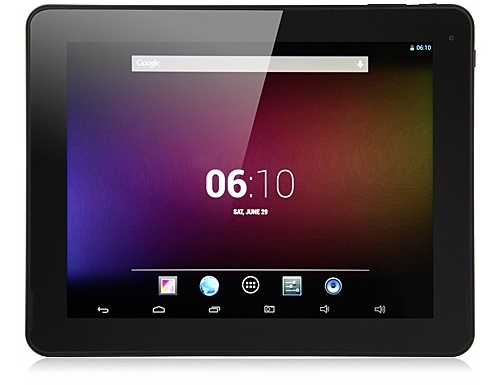Submitted by nbeam85 on

So when I first turned on the PiPo M6 it was running in Full HD mode. I had extremely LOW expectations for performance and to that end I was pleasantly surprised that at such a high resolution the device was still quite usable. Swiping through menus, browsing the web, listening to music... was all a decent experience with some noticeable lag but nothing horrible.
However then I found the magic button in settings that let me reduce the screen resolution (and as a result I dropped the DPI from 264 to 204) and my opinion changed entirely. This isn't just a good tablet, it is a great tablet! Performance is pretty much perfect in "normal mode". This is really a sweet spot for the RK3188 I think. What about display quality? Is it noticeably reduced?
The answer is both yes and no...
For about 90% - 95% of what I do, there isn't much of a difference in image quality between "FULL HD" and "NORMAL" modes on the PiPo M6. I will admit though that there IS an overall perceivable difference, it's just insignificant to me personally as I find it to be very slight.
204 PPI looks great. 264 PPI however is "retina".
But after having spent several weeks with this device now, I think it is fair to say that while many end users could probably "get by" running it at "full HD" resolutions, the majority of us however prefer a more "seamless" user experience and once you go from running on a perfectly smooth device to anything "less" than that, those differences are more noticeable and annoying than the slight loss in display quality from dropping 60 PPI (when you are already above the 200 PPI mark that is...).
Now... there is about 5% - 10% of things that I do that would "more noticeably" benefit from the extra 60 PPI that full HD offers on the PiPo M6. Notably... Magazine reading with tiny text (think, less than 7 pt font on the display). Tiny font has a slight bit of "fuzz". However book reading at 10 - 12 pt font, there is no difference going from 205 - 260 ppi that I can personally see and I have pretty good vision (20/20 in one eye and I am not sure what in the other). The other thing that the extra DPI makes a difference for is very high resolution detail pictured viewing. So if you have some 12+ MegaPixel shots or you have some really cool, highly detailed images (i.e. lots of small details), then going retina is really going to make those pictures "pop". For me though, those times are rare. Your usage may vary.
The other thing you should realize is what a HUGE jump in display sharpness there is when you go from 131 PPI (the iPad 2 and PiPo M1) to 204 PPI (The PiPo M6 in Normal Mode). There is a law of diminishing returns with PPI. As you get higher and higher up, the less and less noticeable the improvement is. What that means is that going from 131 PPI to 206 PPI is an order of magnitude more noticeable than going from 206 PPI to 264 PPI.
So this is a very very big improvement over the PiPo M1 screen. I keep referencing the PiPo M1 because that was one of our best and longest running devices sold at Top Notch Tablets and it is the only other device we have handled in recent history in the 9.7" category.
All-in-All - as I have stated several times before, I am a big fan of "balanced" devices and at 1528x1200 with an RK3188 chipset, that is about as balanced as they come. You are right at the "edge" of starting to noticeably reduce performance. For example, we already know from the Cube U30GT2 and the FNF X2, that at 1920x1200 on the same chipset you do start to have some perceptible, albeit pretty slight, lag. At "FULL HD" on this device (2048x1536) you do see noticeable lag and it is enough to be somewhat annoying. All that being said, 1528x1200 gives you "just enough" performance head-room that you should only ever have excellent performance in pretty much everything you do whilst still have a very good looking display.
Now I will speak specifically to performance, and try to be brief. As noted before, the device works great at 1528x1200. I tested a pretty high-end first person shooter (NOVA 3) and it was quite playable with a little chop but not ruined at all. And it looked very very good at that resolution (vs. playing on a 1024x768 9.7" panel) that the trade-off in loss of performance for visual quality was well worth it. So that is what I would define as "well balanced". However when I attempted the same game on the Cube U30GT2 (running at 1920x1200) the game looked great but ran too choppily (not balanced for gaming...). NOOK, a reading app from Barnes and Noble, ran fine on the Cube U30GT2 but had some slight lag, it had zero lag on the PiPo M6 at 1528x1200 and it had annoying lag at 2048x1536. When lag was noticed at the higher resolution was during page turns and scrolling the library.
All that to reinforce my point, 1528x1200 looks great and performs very well on this chipset but I personally wouldn't run it at full retina. Is it still worth the money? Most definitely if you are in the market for an Android device with the same dimensions as an iPad. This has a seriously good screen and very good performance when ran at 1528x1200 and is a big upgrade over the M1 and other previous-gen tablets from ages past (you know... 6 months ago...).
That's my honest take on the display and performance. Let's talk build-quality and design!
